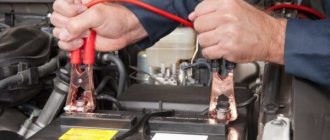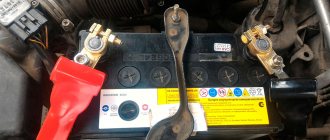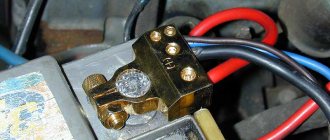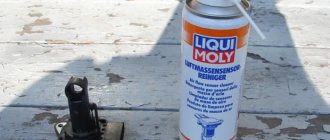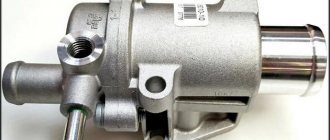During the operation of the car, various parts, elements of the chassis and body are subject to corrosion. Battery terminals are no exception, which often become covered with plaque after some time. This occurs due to poor contact between connections and exposure to aggressive substances. White deposits and rust on the battery contacts prevent normal operation of the battery. In some cases, the battery is poorly charged from the generator and cannot start the engine.
When this problem occurs, it is important to find the cause and eliminate it. In addition, it is necessary to clean the electrical contacts and tighten the connections. It is important to do this in a gentle way so as not to harm the integral structure of the car’s electricity source.
Why lubricate the terminals?
Non-ferrous metals are susceptible to the formation of films consisting of oxides.
For example, if you clean a lead plate to a metallic shine and then leave the part in the open air, a dark film will form on the surface. The formed layer of oxides prevents further decomposition of the material, but impairs electrical conductivity. The introduction of alloying additives into the alloy composition reduces the oxidation rate, but it is impossible to completely eliminate the problem.
The second source of plaque on battery contact plates is sulfuric acid, which is part of the electrolyte. The design of the batteries includes ventilation channels through which acid vapors are emitted to the outside of the case.
In some power supplies, plugs and lids with labyrinthine channels are used to ensure condensation of vapors and drainage of liquid electrolyte back into the jars. Electrolyte that gets onto lead contacts forms a loose white coating, which destroys the material and impairs electrical conductivity.
The acid got onto the terminal and the electrolyte formed a loose white coating on it
When operating a car in winter, lead elements are negatively affected by sodium and potassium salts that are part of de-icing reagents. The substances mix with dirt, oil and electrolyte, and then form a dense crust on the surface of the battery contacts.
When water gets in, the mass begins to corrode metal elements due to electrolysis. The process is not very fast and does not harm the lead contact pins, but it worsens the conditions for the flow of current (for example, at the moment of starting the engine).
Applying lubricants or special substances to previously cleaned terminals allows you to:
- reduce the risk of plaque formation;
- ensure protection of structural elements from corrosion and further destruction;
- maintain the conductivity of electric current through the contact assembly.
How to deal with oxidation? Basic methods
How to clean car battery terminals
The main ones include:
Cleaning with sandpaper.
This method is considered one of the simplest and most accessible. To implement it, it is worth preparing sandpaper or a special brush with metal bristles.
The first step is to remove the terminal from the electrode.
The next step is to take “fine” sandpaper or a brush with metal bristles, and then process the junction of the battery terminal and the tip.
Special attention should be paid to the inside of the terminal. In this case, the work is carried out until shine appears.
The main thing here is not to overdo it, so as not to damage the surface of the product.
The second option is to use gasoline, which also copes well with plaque.
To process it, just moisten a small piece of cloth, then wipe the battery terminals and electrodes with a rag until the surface is completely clear of plaque.
Caution should be exercised during processing due to the easy flammability of gasoline. In addition, it is not recommended to let the device come into contact with rubber or plastic elements (gasoline has a negative effect on them and can destroy them)
The main method of combating oxidation is to monitor the condition of the battery and protect it from electrolyte leakage through the electrodes.
If such a problem occurs, the car owner has two options:
Replace the faulty unit. This option is the most effective, but expensive. Not all car owners are ready to immediately spend a large sum on purchasing a new battery. But if a break appears at the electrode output, there is no other way.
Provide high-quality insulation. Here you can use one of the already proven methods or use modern means of protection (more on them below).
Half-incandescent lights
Another problem is oxidation of the rear light circuit boards.
, familiar to VAZ-2110 owners. When the turn signals are turned on, the headlights and brake lights begin to blink alternately. This lost “mass” is looking for a shortcut. To avoid problems, remove the connector, clean it with 800-1500 grit sandpaper, and treat it with a water displacer.
When installing additional equipment, make sure that the screws do not damage the electrical wiring cables. The worst option is a violation of the integrity of the CAN bus. The number of possible problems is difficult to imagine even for an experienced auto electrician.
Keeping your contacts clean is not at all difficult. This simple procedure will eliminate electrical problems and instill confidence in your car.
Reliable contacts and stable spark!
Topdetal.ru expert Ilya I.
How to lubricate terminals
If the car battery terminals are oxidized: how to clean and what to lubricate
Solid oil, nigrol or litol were used until the 70s of the last century. Then came technical Vaseline. Nowadays, special chemistry such as Batterie-Pol-Fett is used for these purposes. The advantage of modern lubricants is that they form a more durable protective film and are not washed off after washing the car.
In addition, compositions that transmit current are known, but this property is not as important as it seems at first glance
It is recommended to use consistency, ointment-like preparations rather than spraying ones. Such coatings last longer and generally insulate the surface more reliably compared to sprays. But, one way or another, both varieties have the same operating principle - displace water, creating a protective film.
How to clean terminals
The best modern lubricants
As a rule, experts identify 5 types of lubricants that really help against oxidation. They provide a reliable protective layer against corrosion and oxidation with long-term retention. The application process is simple, the temperature range of action is quite wide.
A high-quality lubricant must have a combination of several properties, possessing:
- high acid resistance to prevent the development of oxidative processes;
- high tightness to simultaneously displace moisture;
- dielectricity, allowing economical consumption of battery charge;
- high or medium viscosity, otherwise thermal decomposition of the molecules of the substance will occur, and the lubricant will need to be reapplied;
- a wide range of operating temperatures so that the original properties of the substance are preserved in both winter and summer.
Modern types of lubricants are usually divided into several types:
- silicone, which does an excellent job of repelling aggressive environments, does not lose its properties in the range from -60° to +180°, but has a low degree of viscosity;
- Teflon - their base is also silicone, but this lubricant has a high penetrating ability, so it should not be used for battery terminals;
- oil - the same solid oil or Tsiatim 201, which have high viscosity, are not afraid of moisture, but their operating range is limited;
- Consistent - type Molykote HSC Plus with an oil base and special thickeners;
- copper - with excellent viscosity, good resistance to aggressive agents and high electrical conductivity;
- wax - with high tightness and long-lasting retention;
- graphite - with high resistivity, so it is better not to use it for terminals.
The most popular are oil formulations, which in turn are:
- Vaseline - this is a solid mixture of oil and paraffin, insoluble in water or electrolyte;
- spray - such as Liqui Moly Kupfer-Spray based on mineral oil with color pigment, they retain their original properties well;
- semi-wax, with the addition of copper, etc.
| Lubrication | Base type and viscosity | Operating temperature,℃ | Sealing and acid resistance |
| Molykote HSC Plus | Oil/high | -30°C… +1100°C | High |
| Berner battery pole spray | Oil/medium | -30°C… +130°C | High |
| Presto Batterie-Pol-Schutz | Wax/medium | -30°C… +130°C | High |
| Vmpauto MC1710 | Oil/high | -10°С… +80°С | High |
| Liqui Moly Batterie-Pol-Fett | Oil/high | -40°C… +60°C | High |
What lubricants are suitable for winter?
To protect the terminals from oxidation in cold weather, the use of special compounds is recommended.
The most popular ones include:
- Molykote HSC Plus
- a composition that is intended for FIAMM series batteries, but can also be used for other devices. The advantages are high electrical conductivity and the ability to operate in a wide temperature range (-30...+1100 degrees Celsius). - Cyatim
is an affordable option. Its main disadvantage is low conductivity. - Spray cleaners
. In this series, products from the following manufacturers are in demand - Hi-Gear, SVITOL and others. It is based on purified oil, which, once it hits the surface, “squeezes out” moisture and provides a reliable protective film layer. The latter protects the surface from oxidative processes and the appearance of dirt. The main disadvantage is the short-term effect of the composition. - Grease-type lubricants (options: LIQUI MOLY, Gunk)
. In structure, these are thick compositions that have the appearance of a cream and also have an oil base. Their advantage lies in the ease of application, because you don’t have to worry about getting the composition where it’s not needed. In addition, the lubricant stays on the surface longer and cannot be washed off with shampoo. That is why many craftsmen recommend choosing just such products for winter processing.
Why lubricate?
How to properly charge a gel battery? 2 ways: regular and special charger
There are several reasons here, but initially this is one reason, so:
- In order to improve the electrical contact of the circuit, there are lubricants that actually improve the transmission properties of electricity
- Perhaps the most important reason is its PROTECTIVE PROPERTIES. The thing is that lead (terminals are also made from it) tends to oxidize. Especially under the influence of the environment. Another disadvantage is that on old cars the terminals were made of copper, and the contacts were made of lead; various metals developed oxidation over time. Well, if you take old batteries that were serviced (made using antipyretic technology), then their electrolyte often boiled out of the cans, and quite violently. The fumes came along with some of the sulfuric acid, which could also get on the contacts. Here you go - OXIDATION AGAIN.
By the way, many auto electricians recommend treating the mass of the body with such protective compounds; it can also oxidize over time. Actually, so that nothing oxidizes these contacts and lubricates the terminals, if this is not 100% protection, then at least decay products do not appear for quite a long time.
Causes of oxidation
For what reasons do oxidation processes occur at the terminals?
Oxide deposits are a wake-up call for the car owner to take the necessary measures. It is important to understand the reasons for the occurrence of oxide before stripping the terminals and processing.
Causes:
- In the absence of tightness and insufficient contact of the tip with the battery, the electrolyte evaporates, which causes oxidation.
- Mechanical damage to the terminal - if chipped or scratched, it is better to replace it.
- Lack of tightness at the terminal outlet.
- Overcharging of the generator is often caused by a disruption in the operation of the voltage regulator.
- No weight on the engine.
How to lubricate battery terminals: properties of terminal lubricant
So, if the battery terminal has oxidized (a white coating is visible on the terminals), this is a completely natural process. Active oxidation occurs as a result of the release of electrolyte vapor. Also, we should not forget that the battery is often located under the hood, that is, the environment is far from the most favorable.
One way or another, when a battery terminal oxidizes, it may not even be noticeable at the initial stage, but it negatively affects the battery. The battery discharges faster due to current leakage, the terminals gradually become unusable, etc. In any case, the basic rule is that for the battery to last long, the terminal must be lubricated.
Experienced car owners know this rule well. At the same time, not everyone is aware that the terminals on the battery need to be lubricated only with a suitable lubricant, and not with any lubricant that is at hand.
In other words, the battery terminal care product must be selected correctly
Please note that it is a mistake to believe that battery terminals require any conductive lubricant.
In fact, the lubricant in this case must form a sufficient protective layer to most effectively resist corrosion, oxides, etc. The composition must also remain on the surface for as long as possible, not lose its properties, be able to eliminate sliding discharges, work under conditions of an extended temperature range, etc.
More precisely, lubricant for battery terminals should be a comprehensive solution with a number of specific properties. The main thing is resistance to acids and the ability to prevent the onset and development of oxidative processes. The ability to displace moisture and condensation and protect from contact with oxygen is also important. The lubricant must also be a dielectric to prevent stray currents and battery consumption.
At the same time, the lubricant must be viscous and remain so in conditions of constantly changing temperatures. To put it simply, when heating under the hood, the terminal grease should not flow, since after draining it will need to be re-smeared onto the terminals.
It should be noted that even the special available products do not have such properties in combination. This means that some lubricants protect better from oxidation and moisture, but attract dirt and dust, others are easily washed off or leak when heated, etc.
For this reason, it is necessary to consider in advance the main types of lubricants for battery terminals, as well as what properties this or that lubricant for battery contacts has.
Storage and fixation
If the vehicle will not be used for quite a long time, then it is necessary to provide the battery with optimal storage conditions in advance.
The device must be turned off and removed from the car, since sub-zero temperatures can render it unusable. It is advisable to store the battery in a sufficiently warm and dry room. But you don’t need to place it next to heat sources, otherwise the device will quickly discharge. Deep discharge of the device can negatively affect its condition. To prevent problems, it is advisable to recharge the battery every 3-4 months. So, the device will last as long as possible.
To ensure the safest and most reliable use of the device, it must be properly secured. To check the fixation, you can try to move the battery by hand, turning off the engine first.
It must be taken into account that if the terminals are incorrectly secured, the charging process may be disrupted. Thus, a crooked plane and poorly installed terminals often become the reasons why the car constantly stalls. This affects not only the convenience, but also the safety of vehicle operation.
Causes of whitish plaque
Oxidation processes are a necessary evil for any unprotected metal parts. The contact group of a car battery is no exception, and the main reasons for oxidation of the terminals on a car battery are the following:
- contact with the output terminal of electrolyte. In most cases, such a nuisance is possible due to poorly tightened plugs, but sometimes the reason is more serious - weakening of the rods and the appearance of microscopic cracks;
- physical wear and tear of the car battery is the cause of natural oxidation of the terminals. Here, without purchasing a new device, the problem cannot be radically solved (we remind you that throwing away a used battery at a general waste collection point is strictly prohibited - they must be disposed of only in designated places);
- decrease in electrolyte density. Timely battery maintenance, consisting of regularly checking the level and adding purchased electrolyte, will help solve the problem. On the contrary, diluting the acid on your own will only worsen the situation with contact oxidation.
To determine whether electrolyte is penetrating the terminals through the pin, you should carefully examine where the contacts exit the housing. If there are signs of leaks, the problem is a loss of tightness, and it should be eliminated as quickly as possible.
If the car battery case is made of bakelite, the contact group is usually insulated with mastic. In this case, in the area where the terminal exits the housing, you should carefully remove the old mastic, which has ceased to perform its protective functions, and apply new one.
For plastic cases, a leak in the seal can be eliminated either by applying heated resin around the base, or by treating the terminal with silicone hot-melt adhesive applied using a hot-melt gun.
Additionally, you can seal the terminal terminal using felt if the cause of oxidation of the positive terminal of the battery is precisely the contact of electrolyte on the surface. To do this, you need to cut two small rings from a felt blank, the inner diameter of which should correspond to the outer diameter of the terminal at the base. A felt thickness of 4-5 millimeters will be enough. Before laying the washer on top of the resin or silicone, it must be carefully moistened with engine oil. The wire lugs placed on the terminals will tightly press the felt pad, ensuring perfect tightness of the connection. Instead of felt, you can also use felt, which has a similar fiber structure.
Another reason why the negative terminal on the battery oxidizes is poor contact between the terminal and the wire clamp. In this case, oxidation occurs due to the contact group of water vapor present in the air, as well as electrolyte vapor. When current passes through the surface of the terminal, the anode begins to collapse, and the notorious white coating begins to accumulate in the resulting cracks, gradually spreading to nearby areas.
So when installing a battery, be very careful about ensuring tight contact between the wire and the terminal. To do this, some motorists additionally tap the clamp, which should not be done, since such actions can lead to disruption of the integrity of the recesses around the terminals.
The best way to crimp is to use a standard fastener, without being lazy, tighten the bolted connection each time using wrenches (or a wrench and a screwdriver).
Finally, clogging of the ventilation holes that supply the battery banks leads to an increase in the internal pressure of the electrolyte, which leads to its squeezing out through openings not provided for this purpose.
Secrets of prevention
It is important to understand that even in a new battery, minor acid vapors occur. This means that the best way to protect against trouble is to ensure the product is sealed.
It is prohibited to apply special materials directly to the contact site. First, the area is cleaned, wiped, and after connection the treatment is carried out.
Popular methods of protection include:
- Felt and oil
. This technique has been known for many decades. The main advantage is accessibility, which determines the popularity of the products among car owners. To avoid electrolyte vapors from entering the terminal and the appearance of oxides, it is enough to cover it with felt (pre-treated with machine oil). All that is required is to cut a round felt gasket with a hole in the center, then soak it in oil and put it on the battery terminal. After this, the on-board network terminal is put on the contact. It must be screwed on, and a felt pad soaked in oil must be placed on top. - Classic remedies are Vaseline, grease and varnish
. Experts assure that to protect the terminals you can use almost any liquid composition that provides insulation and is resistant to shampoos. Silicone-based lubricants are suitable here, they are affordable and do not absorb various debris (dust and dirt). - Anti-fat
- a special lubricating composition that has anti-corrosion properties and does not impair the conductivity of the contact connection. This product is sold in aerosol form, and processing is carried out by conventional application to the terminals. Anti-grease is sold in many automotive stores. - Felt washers
. Here the processing principle is the same as in the case of felt products. The washer is put on top to prevent the terminals from oxidizing.
The battery terminal is oxidized. Causes
There are not many answers to the question of why battery terminals oxidize. The most common reason for the formation of loose oxide is interaction with acid vapors
It is important to promptly protect the battery terminals from oxidation, since the regularly formed layer of oxidized lead significantly reduces the reliability of electrical contact, which gradually damages the battery itself and affects the operation of other vehicle mechanisms.
Why do battery terminals oxidize?
The reasons for this process are:
- Violation of the seal of the housing, as a result of which the electrolyte leaks and interacts with the lead terminals. There is no time to delay in eliminating this problem, because... Over time, the acid is quite capable of eating through the body itself.
- Regular recharging of the battery leads to overheating of the electrolyte and its intense evaporation.
As you can see, there are only two reasons for the oxidation of battery terminals, so finding the original source will not leave the problem difficult. The main thing is to detect and eliminate it as early as possible. Then the least damage will be caused to the car.
Many car operating manuals, when answering the question of why the negative terminal oxidizes, indicate the importance of disconnecting the mass during long periods of inactivity, otherwise constant mechanical stress can lead to a violation of the tightness at the point where this terminal passes through the body
What can I do to prevent battery terminals from oxidizing?
Even if the battery is fully operational, acid still evaporates, albeit slightly. In this case, it is enough to simply seal the connection. To do this, you can use oiled felt rings applied to the output pins. A special lubricant also helps protect the battery terminals from oxidation. It helps protect lead from acid attack.
In the simplest version, when neither one nor the other is at hand, you can use technical petroleum jelly or grease. However, these “sealants” will collect all the dirt.
When wondering how to lubricate the battery terminals to prevent oxidation, it is important to consider that the protective lubricant should not get into the contact area. The pin and terminals must be reliably protected and carefully wiped dry, and after connection they must be securely fixed, and only after completing these measures can protection be applied
Some car enthusiasts, when checking the oil level, touch the terminals with a dipstick, which in principle quite reliably protects the connection from oxidation.
How to clean battery terminals from oxidation?
Everyone chooses the method of such cleaning for themselves. However, the most effective treatment is considered to be an ordinary solution of baking soda, as well as Coca-Cola or mineral water. Which one to choose is up to you. Each liquid allows you to effectively clean the battery terminals from oxidation.
How to lubricate terminals from oxidation
The main purpose of lubricating electrical connections is to prevent dirt and air oxygen from entering the contact area, which helps prevent them from oxidizing.
It is desirable that the protective coating does not collect excess dirt and performs its protective functions for as long as possible. There are many different options for protecting battery terminals, each of which has certain advantages and disadvantages. The main condition should be the absence of a corrosive effect on contacts, wire insulation and surrounding rubber parts, high temperature and acid resistance.
These are compositions, usually based on mineral oil with the addition of graphite powder. They have good water-repellent properties and excellent protection against corrosion. A regular graphite lubricant can withstand temperatures from -20 to +70 degrees, but there are also more expensive high-temperature options. Due to possible overheating of the engine compartment in hot weather, it is better to use them.
Graphite is a good conductor of electric current, so its penetration into the contact joint does not degrade the electrical contact as much as a grease with dielectric properties does.
This type of lubricant can withstand high temperatures, has anti-corrosion properties, adheres well to the surface, but does not conduct electricity. They are made on an oil basis with the addition of special additives and dyes that facilitate the application of a protective coating.
This is a good option for protection against oxidation when using special protection compounds, for example from LiquiMoly, Addinol, Molykote, Gunk and others.
These lubricants are durable, have high viscosity, conduct electricity well, withstand high temperatures (from -35 to several hundred degrees), and provide excellent protection against corrosion, moisture, and burnouts.
Special copper lubricants for electrical contacts are available in the form of sprays, for example, Berner, as well as copper dabs for highly loaded moving joints. They have different properties, but both options can be used to protect battery contacts.
These lubricants can withstand temperatures from -30 to +130 degrees, have a medium viscosity, adhere well to the surface and provide high tightness of electrical contacts.
A good wax-based composition is Presto Batterie Pol Schutz, which can withstand temperatures from -30 to +130 degrees and is easily applied using an aerosol spray.
This is an excellent option for protecting contact connections with good resistance to hot vapors and disinfectant solutions. Silicone grease adheres well to surfaces, is neutral and can work over a wide temperature range from -40 to +150 degrees. Produced by many trusted manufacturers, including Shell, Fuchs, Molykote, Roco and others.
The disadvantage of silicone lubricants is the need to regularly renew the protective coating.
These include such common compounds as solid oil, litol, cyatim 201, and petroleum jelly. These compounds are used to protect rubbing surfaces from wear; they have high fluidity, which increases with increasing temperature in the engine compartment, so they are not very suitable for protecting electrical contacts. If there are serious problems with contact oxidation, they can be used to protect the terminals, but it is better to do this only in the winter season, when these lubricants are less fluid.
There are special formulations based on mineral oils containing special additives that improve their temperature resistance and therefore make it possible to use them to protect terminals. These include:
- Liqui Moly Kupfer Spray is an oil lubricant with copper powder added, designed for brake pads. It can also be used as a protective coating for the outer surface of contacts;
- Liqui Moly Batterie Pol Fett is a special protective lubricant with red dye. Permissible temperatures are from -40 to +60 degrees.
- Vmpauto MC1710 is a mixture of various oils, as well as silicone with a blue dye. Can be used at temperatures from -10 to +80 degrees.
These lubricants are designed to form a dry coating on the rubbing parts. They are not very suitable for protecting electrical contacts due to their high penetrability, which can impair electrical contact.
Loss of contact in the battery terminals, where very strong currents flow, is not only undesirable, but also dangerous. In this regard, it is not recommended to use Teflon lubricants on contact connections.
The easiest way to clean contacts
Asidolom is ammonia, found in almost every car first aid kit. First, you need to conduct an experiment on the removed sensor connector. The surface is generously moistened with the poured composition from the bubble, then the coating must be rubbed with a match. After treatment, the contact becomes shiny and clean. Then the surface is washed off with water using an enema and blown with air with the same device.
Another name is “Ammonia” Source monetnik.ru
The product is manufactured at the Lenbytkhim enterprise.

